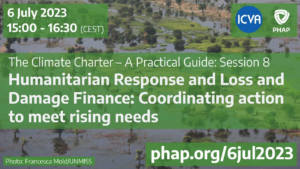-
Search -
Accessibility -
Members Login
Humanitarian Response and Loss and Damage Finance: Coordinating Action to Meet Rising Needs
ICVA and PHAP
Webinar
English
Climate & environment
Climate change has caused natural disasters, food and water shortages, and health problems that greatly affect people’s livelihoods. While climate finance and humanitarian response share a common goal of reducing the occurrence and magnitude of crises, they have different financing mechanisms, resulting in significant gaps in coverage and poor coordination. As a result, those most affected by climate disasters are often neglected and left to bear the burden of climate change, becoming increasingly vulnerable to additional crises.
Allocating additional financial resources to address loss and damage, specifically aimed at preventing, reducing, and addressing the negative impacts of climate change, would primarily support countries impacted by climate change in their efforts to prepare for, recover from and rehabilitate after climatic events. Loss and Damage finance is therefore a supplement to, not a replacement for, existing humanitarian and climate finance.
The webinar explored how the climate finance and humanitarian response can better work together to respond to climate-related emergencies. The expert panel examined how climate loss and damage financing is related to humanitarian response, what the two sectors can learn from each other, and what lessons can be drawn from existing coordination efforts. This set the stage for more substantive dialogues between the two sectors about how to jointly support or advocate for Loss and Damage finance.


Check out presentations, resources and further reading related to the Climate Charter’s Topic 8 on Humanitarian Response and Loss and Damage Finance: Coordinating Action to Meet Rising Needs